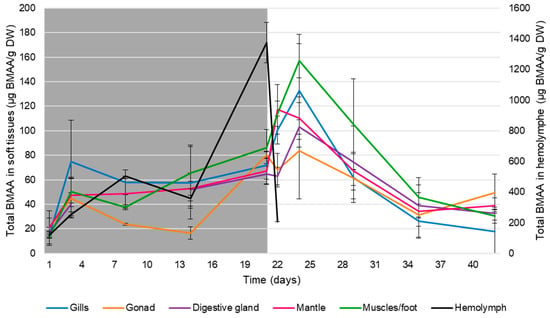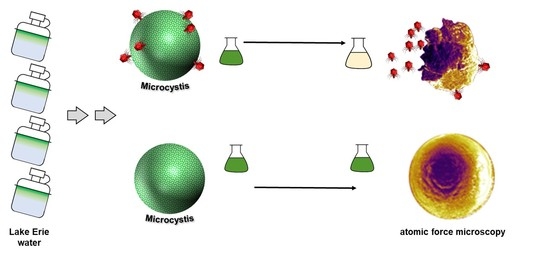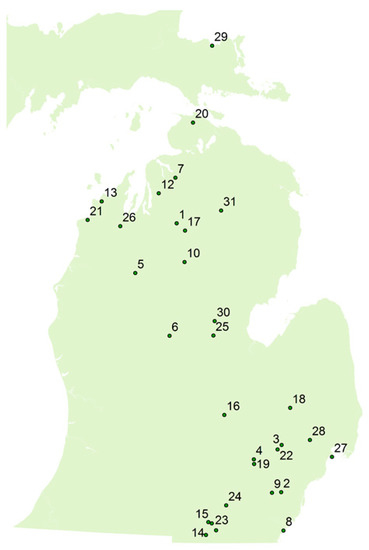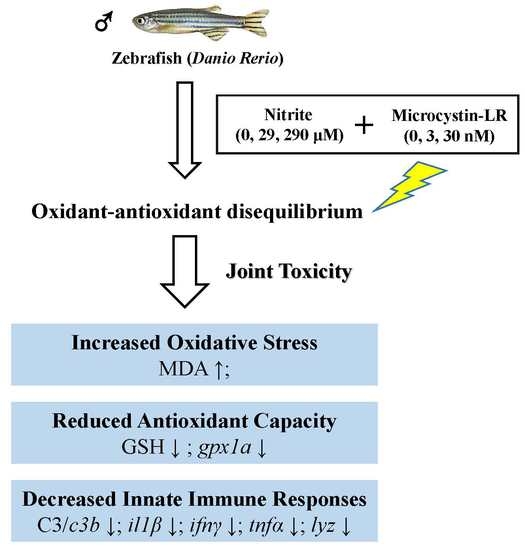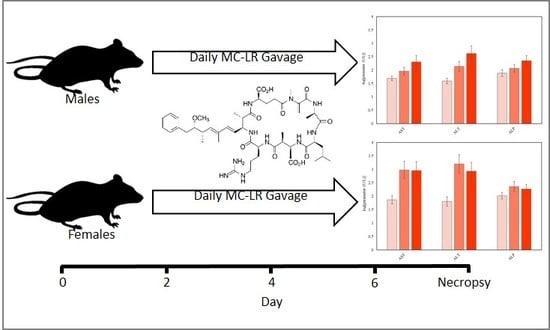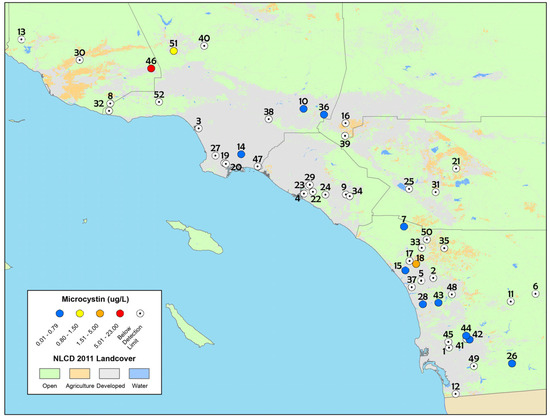Freshwater HABs and Health in a Changing World
(Closed)
Share This Topical Collection
Editors
 Dr. Elizabeth D. Hilborn
Dr. Elizabeth D. Hilborn
 Dr. Elizabeth D. Hilborn
Dr. Elizabeth D. Hilborn
E-Mail
Collection Editor
United States Environmental Protection Agency, Office of Research and Development, National Health and Environmental Effects Research Laboratory, Research Triangle Park, NC 27703, USA
Special Issues, Collections and Topics in MDPI journals
Topical Collection Information
Dear Colleagues,
The Special Issue on Harmful Algal Blooms (HABs) and Public Health: Progress and Current Challenges included research papers and reviews on various aspects of HABs and public health, including HAB occurrence, human health risk assessment, water treatment techniques, and regulatory guideline development. This Special Issue touched on a number of topics that need further exploration, including characterizing cyanobacterial toxin poisonings associated with drinking contaminated water or eating contaminated food, HAB-related illnesses from exposures during recreational water activities, and understanding cyanobacteria bloom-associated fish kills and poisonings of companion animals, livestock, and wildlife. This Topical Collection entitled Freshwater HABs and Health in a Changing World serves as a forum to further discuss these topics and address challenges in assessing freshwater HAB-associated effects on public health and the environment. Manuscripts are invited that provide information about exposure assessment; health outcomes; outbreak investigations; wild and domestic animal poisonings; toxicology of cyanobacterial toxins in animals and humans, and the production of toxins in the environment. Manuscripts on the absorption, distribution, and elimination of toxins in animals and humans, and the control of toxins in the built and natural environment, as well as related topics are also invited.
Dr. Lesley V. D'Anglada
Dr. Elizabeth Hilborn
Dr. Lorraine C. Backer
Collection Editors
Manuscript Submission Information
Manuscripts should be submitted online at www.mdpi.com by registering and logging in to this website. Once you are registered, click here to go to the submission form. Manuscripts can be submitted until the deadline. All submissions that pass pre-check are peer-reviewed. Accepted papers will be published continuously in the journal (as soon as accepted) and will be listed together on the collection website. Research articles, review articles as well as short communications are invited. For planned papers, a title and short abstract (about 100 words) can be sent to the Editorial Office for announcement on this website.
Submitted manuscripts should not have been published previously, nor be under consideration for publication elsewhere (except conference proceedings papers). All manuscripts are thoroughly refereed through a double-blind peer-review process. A guide for authors and other relevant information for submission of manuscripts is available on the Instructions for Authors page. Toxins is an international peer-reviewed open access monthly journal published by MDPI.
Please visit the Instructions for Authors page before submitting a manuscript.
The Article Processing Charge (APC) for publication in this open access journal is 2700 CHF (Swiss Francs).
Submitted papers should be well formatted and use good English. Authors may use MDPI's
English editing service prior to publication or during author revisions.
Keywords
- harmful algal blooms
- cyanobacteria
- blue-green algae
- cyanotoxins
- red tides
- public health
- drinking water treatment
- monitoring
- treatment
- prevention
- public health surveillance
- environmental health
- environmental contaminants and human health
Related Special Issue
Published Papers (10 papers)
Open AccessArticle
How the Neurotoxin β-N-Methylamino-l-Alanine Accumulates in Bivalves: Distribution of the Different Accumulation Fractions among Organs
by
Alexandra Lepoutre, Elisabeth J. Faassen, A. J. Zweers, Miquel Lürling, Alain Geffard and Emilie Lance
Cited by 9 | Viewed by 3032
Abstract
The environmental neurotoxin β-methylamino-
l-alanine (BMAA) may represent a risk for human health. BMAA accumulates in freshwater and marine organisms consumed by humans. However, few data are available about the kinetics of BMAA accumulation and detoxification in exposed organisms, as well as
[...] Read more.
The environmental neurotoxin β-methylamino-
l-alanine (BMAA) may represent a risk for human health. BMAA accumulates in freshwater and marine organisms consumed by humans. However, few data are available about the kinetics of BMAA accumulation and detoxification in exposed organisms, as well as the organ distribution and the fractions in which BMAA is present in tissues (free, soluble bound or precipitated bound cellular fractions). Here, we exposed the bivalve mussel
Dreissena polymorpha to 7.5 µg of dissolved BMAA/mussel/3 days for 21 days, followed by 21 days of depuration in clear water. At 1, 3, 8, 14 and 21 days of exposure and depuration, the hemolymph and organs (digestive gland, the gills, the mantle, the gonad and muscles/foot) were sampled. Total BMAA as well as free BMAA, soluble bound and precipitated bound BMAA were quantified by tandem mass spectrometry. Free and soluble bound BMAA spread throughout all tissues from the first day of exposure to the last day of depuration, without a specific target organ. However, precipitated bound BMAA was detected only in muscles and foot from the last day of exposure to day 8 of depuration, at a lower concentration compared to free and soluble bound BMAA. In soft tissues (digestive gland, gonad, gills, mantle and muscles/foot), BMAA mostly accumulated as a free molecule and in the soluble bound fraction, with variations occurring between the two fractions among tissues and over time. The results suggest that the assessment of bivalve contamination by BMAA may require the quantification of total BMAA in whole individuals when possible.
Full article
►▼
Show Figures
Open AccessArticle
Characterization of Cyanophages in Lake Erie: Interaction Mechanisms and Structural Damage of Toxic Cyanobacteria
by
Xuewen Jiang, Chanhee Ha, Seungjun Lee, Jinha Kwon, Hanna Cho, Tyler Gorham and Jiyoung Lee
Cited by 18 | Viewed by 6743
Abstract
Cyanophages are abundant in aquatic environments and play a critical role in bloom dynamics, including regulation of cyanobacteria growth and photosynthesis. In this study, cyanophages from western Lake Erie water samples were screened for lytic activity against the host cell (
Microcystis aeruginosa
[...] Read more.
Cyanophages are abundant in aquatic environments and play a critical role in bloom dynamics, including regulation of cyanobacteria growth and photosynthesis. In this study, cyanophages from western Lake Erie water samples were screened for lytic activity against the host cell (
Microcystis aeruginosa), which also originated from Lake Erie, and identified with real-time sequencing (Nanopore sequencing).
M. aeruginosa was mixed with the cyanophages and their dynamic interactions were examined over two weeks using atomic force microscopy (AFM) as well as transmission electron microscopy (TEM), qPCR, phycocyanin and chlorophyll-a production, and optical absorbance measurements. The TEM images revealed a short-tailed virus (
Podoviridae) in 300 nm size with unique capsid, knob-like proteins. The
psbA gene and one knob-like protein gene,
gp58, were identified by PCR. The AFM showed a reduction of mechanical stiffness in the host cell membranes over time after infection, before structural damage became visible. Significant inhibition of the host growth and photosynthesis was observed from the measurements of phycocyanin and chlorophyll-a concentrations. The results provide an insight into cyanobacteria–cyanophage interactions in bloom dynamics and a potential application of cyanophages for bloom control in specific situations.
Full article
►▼
Show Figures
Open AccessEditor’s ChoiceArticle
Comparative Analysis of Microcystin Prevalence in Michigan Lakes by Online Concentration LC/MS/MS and ELISA
by
Johnna A. Birbeck, Judy A. Westrick, Grace M. O’Neill, Brian Spies and David C. Szlag
Cited by 53 | Viewed by 6043
Abstract
Fast and reliable workflows are needed to quantitate microcystins (MCs), a ubiquitous class of hepatotoxic cyanotoxins, so that the impact of human and environmental exposure is assessed quickly and minimized. Our goal was to develop a high-throughput online concentration liquid chromatography tandem mass
[...] Read more.
Fast and reliable workflows are needed to quantitate microcystins (MCs), a ubiquitous class of hepatotoxic cyanotoxins, so that the impact of human and environmental exposure is assessed quickly and minimized. Our goal was to develop a high-throughput online concentration liquid chromatography tandem mass spectrometry (LC/MS/MS) workflow to quantitate the 12 commercially available MCs and nodularin in surface and drinking waters. The method run time was 8.5 min with detection limits in the low ng/L range and minimum reporting levels between 5 and 10 ng/L. This workflow was benchmarked by determining the prevalence of MCs and comparing the Adda-ELISA quantitation to our new workflow from 122 samples representing 31 waterbodies throughout Michigan. The frequency of MC occurrence was MC-LA > LR > RR > D-Asp
3-LR > YR > HilR > WR > D-Asp
3-RR > HtyR > LY = LW = LF, while MC-RR had the highest concentrations. MCs were detected in 33 samples and 13 of these samples had more than 20% of their total MC concentration from MCs not present in US Environmental Protection Agency (US EPA) Method 544. Furthermore, seasonal deviations between the LC/MS/MS and Adda-ELISA data suggest Adda-ELISA cross-reacts with MC degradation products. This workflow provides less than 24-h turnaround for quantification and also identified key differences between LC/MS/MS and ELISA quantitation that should be investigated further.
Full article
►▼
Show Figures
Open AccessArticle
Nitrite Enhances MC-LR-Induced Changes on Splenic Oxidation Resistance and Innate Immunity in Male Zebrafish
by
Wang Lin, Honghui Guo, Lingkai Wang, Dandan Zhang, Xueyang Wu, Li Li, Dapeng Li and Rong Tang
Cited by 25 | Viewed by 3680
Abstract
Hazardous contaminants, such as nitrite and microcystin-leucine arginine (MC-LR), are released into water bodies during cyanobacterial blooms and may adversely influence the normal physiological function of hydrobiontes. The combined effects of nitrite and MC-LR on the antioxidant defense and innate immunity were evaluated
[...] Read more.
Hazardous contaminants, such as nitrite and microcystin-leucine arginine (MC-LR), are released into water bodies during cyanobacterial blooms and may adversely influence the normal physiological function of hydrobiontes. The combined effects of nitrite and MC-LR on the antioxidant defense and innate immunity were evaluated through an orthogonal experimental design (nitrite: 0, 29, 290 μM; MC-LR: 0, 3, 30 nM). Remarkable increases in malondialdehyde (MDA) levels have suggested that nitrite and/or MC-LR exposures induce oxidative stress in fish spleen, which were indirectly confirmed by significant downregulations of total antioxidant capacity (T-AOC), glutathione (GSH) contents, as well as transcriptional levels of antioxidant enzyme genes
cat1,
sod1 and
gpx1a. Simultaneously, nitrite and MC-LR significantly decreased serum complement C3 levels as well as the transcriptional levels of splenic
c3b,
lyz,
il1β,
ifnγ and
tnfα, and indicated that they could jointly impact the innate immunity of fish. The severity and extent of splenic lesions were aggravated by increased concentration of nitrite or MC-LR and became more serious in combined groups. The damages of mitochondria and pseudopodia in splenic macrophages suggest that oxidative stress exerted by nitrite and MC-LR aimed at the membrane structure of immune cells and ultimately disrupted immune function. Our results clearly demonstrate that nitrite and MC-LR exert synergistic suppressive effects on fish innate immunity via interfering antioxidant responses, and their joint toxicity should not be underestimated in eutrophic lakes.
Full article
►▼
Show Figures
Open AccessArticle
Impact of Microcystin-LR on Liver Function Varies by Dose and Sex in Mice
by
Igor Mrdjen, Mark A. Morse, Randall J. Ruch, Thomas J. Knobloch, Shambhunath Choudhary, Christopher M. Weghorst and Jiyoung Lee
Cited by 18 | Viewed by 4326
Abstract
Microcystin (MC) exposure is an increasing concern because more geographical locations are covered with cyanobacterial blooms as eutrophication and bloom-favoring environmental factors become more prevalent worldwide. Acute MC exposure has been linked to gastrointestinal distress, liver toxicity, and death in extreme circumstances. The
[...] Read more.
Microcystin (MC) exposure is an increasing concern because more geographical locations are covered with cyanobacterial blooms as eutrophication and bloom-favoring environmental factors become more prevalent worldwide. Acute MC exposure has been linked to gastrointestinal distress, liver toxicity, and death in extreme circumstances. The goal of this study was to provide an accurate and comprehensive description of MC-LRs impacts on liver pathology, clinical chemistry, and gap junction intercellular communication (GJIC) in CD-1 male and female mice. Mice were exposed to 0, 3000, and 5000/4000 µg/kg/day MC-LR, daily for 7 days, and were necropsied on Day 8. Blood samples for clinical chemistry analysis were processed to serum, while liver sections were fixed for histopathology or evaluated for GJIC using fluorescent cut-load dye. Results show a dose-dependent relationship with MC-LR exposure and hepatocellular hypertrophy, degradation, and necrosis. Clinical chemistry parameters alanine aminotransferase, aspartate aminotransferase, alkaline phosphatase, total bilirubin, and cholesterol increased significantly in MC-LR exposed mice. Clinical chemistry parameter analysis showed significantly increased susceptibility to MC-LR in females compared to males. Changes in GJIC were not noted, but localization of hepatotoxicity near the central veins and midlobular areas was seen. Future toxicity studies involving MCs should consider response differences across sexes, differing MC congeners, and combinatorial exposures involving other cyanotoxins.
Full article
►▼
Show Figures
Open AccessArticle
Removal of Microcystin-LR by a Novel Native Effective Bacterial Community Designated as YFMCD4 Isolated from Lake Taihu
by
Fei Yang, Jian Guo, Feiyu Huang, Isaac Yaw Massey, Ruixue Huang, Yunhui Li, Cong Wen, Ping Ding, Weiming Zeng and Geyu Liang
Cited by 32 | Viewed by 4583
Abstract
Microcystin-LR (MC-LR) is the most toxic and frequently detected monocyclic heptapeptide hepatotoxin produced by cyanobacteria, which poses a great threat to the natural ecosystem and public health. It is very important to seek environment-friendly and cost-efficient methods to remove MC-LR in water. In
[...] Read more.
Microcystin-LR (MC-LR) is the most toxic and frequently detected monocyclic heptapeptide hepatotoxin produced by cyanobacteria, which poses a great threat to the natural ecosystem and public health. It is very important to seek environment-friendly and cost-efficient methods to remove MC-LR in water. In this study, the MC-degrading capacities of a novel indigenous bacterial community designated as YFMCD4 and the influence of environmental factors including various temperatures, MC concentrations and pH on the MC-degrading activities were investigated utilizing high-performance liquid chromatography (HPLC). In addition, the MC-degrading mechanism of YFMCD4 was also studied using HPLC coupled with a mass spectrometry equipped with electrospray ionization interface (HPLC-ESI-MS). The data showed MC-LR was completely removed at the maximum rate of 0.5 µg/(mL·h) under the optimal condition by YFMCD4. Two pure bacterial strains
Alcaligenes faecalis and
Stenotrophomonas acidaminiohila were isolated from YFMCD4 degraded MC-LR at a slower rate. The MC-degrading rates of YFMCD4 were significantly affected by different temperatures, pH and MC-LR concentrations. Two intermediates of a tetrapeptide and Adda appeared in the degradation process. These results illustrate that the novel YFMCD4 is one of the highest effective MC-degrading bacterial community, which can completely remove MC-LR and possesses a significant potential to treat water bodies contaminated by MC-LR.
Full article
►▼
Show Figures
Open AccessArticle
Microcystin Prevalence throughout Lentic Waterbodies in Coastal Southern California
by
Meredith D. A. Howard, Carey Nagoda, Raphael M. Kudela, Kendra Hayashi, Avery Tatters, David A. Caron, Lilian Busse, Jeff Brown, Martha Sutula and Eric D. Stein
Cited by 35 | Viewed by 6493
Abstract
Toxin producing cyanobacterial blooms have increased globally in recent decades in both frequency and intensity. Despite the recognition of this growing risk, the extent and magnitude of cyanobacterial blooms and cyanotoxin prevalence is poorly characterized in the heavily populated region of southern California.
[...] Read more.
Toxin producing cyanobacterial blooms have increased globally in recent decades in both frequency and intensity. Despite the recognition of this growing risk, the extent and magnitude of cyanobacterial blooms and cyanotoxin prevalence is poorly characterized in the heavily populated region of southern California. Recent assessments of lentic waterbodies (depressional wetlands, lakes, reservoirs and coastal lagoons) determined the prevalence of microcystins and, in some cases, additional cyanotoxins. Microcystins were present in all waterbody types surveyed although toxin concentrations were generally low across most habitats, as only a small number of sites exceeded California’s recreational health thresholds for acute toxicity. Results from passive samplers (Solid Phase Adsorption Toxin Tracking (SPATT)) indicated microcystins were prevalent throughout lentic waterbodies and that traditional discrete samples underestimated the presence of microcystins. Multiple cyanotoxins were detected simultaneously in some systems, indicating multiple stressors, the risk of which is uncertain since health thresholds are based on exposures to single toxins. Anatoxin-a was detected for the first time from lakes in southern California. The persistence of detectable microcystins across years and seasons indicates a low-level, chronic risk through both direct and indirect exposure. The influence of toxic cyanobacterial blooms is a more complex stressor than presently recognized and should be included in water quality monitoring programs.
Full article
►▼
Show Figures
Open AccessArticle
Eutrophication and Warming Boost Cyanobacterial Biomass and Microcystins
by
Miquel Lürling, Frank Van Oosterhout and Elisabeth Faassen
Cited by 103 | Viewed by 9807
Abstract
Eutrophication and warming are key drivers of cyanobacterial blooms, but their combined effects on microcystin (MC) concentrations are less studied. We tested the hypothesis that warming promotes cyanobacterial abundance in a natural plankton community and that eutrophication enhances cyanobacterial biomass and MC concentrations.
[...] Read more.
Eutrophication and warming are key drivers of cyanobacterial blooms, but their combined effects on microcystin (MC) concentrations are less studied. We tested the hypothesis that warming promotes cyanobacterial abundance in a natural plankton community and that eutrophication enhances cyanobacterial biomass and MC concentrations. We incubated natural seston from a eutrophic pond under normal, high, and extreme temperatures (i.e., 20, 25, and 30 °C) with and without additional nutrients added (eutrophication) mimicking a pulse as could be expected from projected summer storms under climate change. Eutrophication increased algal- and cyanobacterial biomass by 26 and 8 times, respectively, and led to 24 times higher MC concentrations. This effect was augmented with higher temperatures leading to 45 times higher MC concentrations at 25 °C, with 11 times more cyanobacterial chlorophyll-
a and 25 times more eukaryote algal chlorophyll-
a. At 30 °C, MC concentrations were 42 times higher, with cyanobacterial chlorophyll-
a being 17 times and eukaryote algal chlorophyll-
a being 24 times higher. In contrast, warming alone did not yield more cyanobacteria or MCs, because the in situ community had already depleted the available nutrient pool. MC per potential MC producing cell declined at higher temperatures under nutrient enrichments, which was confirmed by a controlled experiment with two laboratory strains of
Microcystis aeruginosa. Nevertheless, MC concentrations were much higher at the increased temperature and nutrient treatment than under warming alone due to strongly promoted biomass, lifting N-imitation and promotion of potential MC producers like
Microcystis. This study exemplifies the vulnerability of eutrophic urban waters to predicted future summer climate change effects that might aggravate cyanobacterial nuisance.
Full article
►▼
Show Figures
Open AccessArticle
miR-541 Contributes to Microcystin-LR-Induced Reproductive Toxicity through Regulating the Expression of p15 in Mice
by
Xiannan Meng, Ling Zhang, Xiang Chen, Zou Xiang, Dongmei Li and Xiaodong Han
Cited by 15 | Viewed by 5697
Abstract
Microcystin-leucine arginine (MC-LR) is a harmful cyanotoxin produced by cyanobacteria. MC-LR can exert endocrine-disrupting activities in many organisms. We have previously demonstrated that MC-LR exerts both acute and chronic reproductive toxicity in male mice, resulting in a decline in sperm quality and damage
[...] Read more.
Microcystin-leucine arginine (MC-LR) is a harmful cyanotoxin produced by cyanobacteria. MC-LR can exert endocrine-disrupting activities in many organisms. We have previously demonstrated that MC-LR exerts both acute and chronic reproductive toxicity in male mice, resulting in a decline in sperm quality and damage to testicular structure. Moreover, we also observed extensive alterations in a panel of microRNAs in spermatogonial cells after exposure to MC-LR. In this study, we have confirmed that miR-541 was significantly increased both in GC-1 cells (in vitro) and in mouse testes (in vivo) after exposure to MC-LR. Our data support that p15 was the target gene of miR-541. Increase in miR-541 led to a reduction of p15 and murine double minute2 (MDM2), promoting the activation of p53 signaling and MC-LR-mediated cell apoptosis. Moreover, cells responded to MC-LR with reduced viability and increased apoptosis. Consistently, inhibiting miR-541 could upregulate the expression of p15 and MDM2, resulting in the downregulation of phospho-p53. Downregulation of miR-541 promoted cell viability by reducing MC-LR-induced cell apoptosis. In conclusion, we demonstrate here a crucial role for miR-541 in MC-LR-induced toxic effects on the reproductive system, in an attempt to provide a rational strategy for the diagnosis and treatment of MC-LR-induced impairment in the reproductive system.
Full article
►▼
Show Figures
Open AccessArticle
Development of Toxicological Risk Assessment Models for Acute and Chronic Exposure to Pollutants
by
Elke S. Reichwaldt, Daniel Stone, Dani J. Barrington, Som C. Sinang and Anas Ghadouani
Cited by 12 | Viewed by 6928
Abstract
Alert level frameworks advise agencies on a sequence of monitoring and management actions, and are implemented so as to reduce the risk of the public coming into contact with hazardous substances. Their effectiveness relies on the detection of the hazard, but with many
[...] Read more.
Alert level frameworks advise agencies on a sequence of monitoring and management actions, and are implemented so as to reduce the risk of the public coming into contact with hazardous substances. Their effectiveness relies on the detection of the hazard, but with many systems not receiving any regular monitoring, pollution events often go undetected. We developed toxicological risk assessment models for acute and chronic exposure to pollutants that incorporate the probabilities that the public will come into contact with undetected pollution events, to identify the level of risk a system poses in regards to the pollutant. As a proof of concept, we successfully demonstrated that the models could be applied to determine probabilities of acute and chronic illness types related to recreational activities in waterbodies containing cyanotoxins. Using the acute model, we identified lakes that present a ‘high’ risk to develop Day Away From Work illness, and lakes that present a ‘low’ or ‘medium’ risk to develop First Aid Cases when used for swimming. The developed risk models succeeded in categorising lakes according to their risk level to the public in an objective way. Modelling by how much the probability of public exposure has to decrease to lower the risks to acceptable levels will enable authorities to identify suitable control measures and monitoring strategies. We suggest broadening the application of these models to other contaminants.
Full article
►▼
Show Figures






